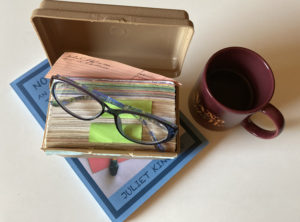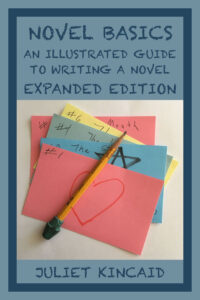Juliet Kincaid, Novel Writer
I wasn’t the girl who wanted to write when she grew up. No, I was the girl who read novels voraciously. I was the girl who went to the Carnegie Library in her home town every summer Monday to return the six books she read the past week and to check out six more. (I had no time to read on Sundays.) Moving upstairs from the children’s department in the basement to the adult section on the main floor of the library was a cause for celebration for me.
In my fourteenth summer, I began my life list of books I’ve read on 3” X 5” index cards with The Saint on the Spanish Main by Leslie Charteris. Since then, I’ve read well over 3,000 books (and in some cases reread them), mostly novels, mostly mysteries with some SF/F here and there. My list reflects my love of novels with action, adventure, interesting settings, some humor, strong plots, protagonists that I can identify with, and a bit of romance. Novels create worlds that I can escape into, something I appreciate. Don’t you?

It wasn’t until graduate school that I first wrote a novel, a novel in diary form, for the very work-a-day reason of exploring the subject of my dissertation: the novel in diary form. In 1986, I finally resumed writing novels myself instead of just reading them, in summers before I retired, and almost every day of my life, twenty hours a week, since then.
I have now at least drafted fifteen to nineteen novels along with many short stories. The exact number is unclear even to me because some of the novels, Death in Shining Armor, for instance, I’ve counted more than once because the versions of them differed so much. Others are so large that I’ve split them into series. I’ve published seven novels (so far).
Besides these novels, I’ve also written a guide to writing novels called Novel Basics. The current, expanded version, includes information on brainstorming, writing, and publishing a novel. You can buy Novel Basics in paperback for $9.99 in the easy-to-read 14-point font from Amazon and for $3.99 from a variety of different vendors including
Amazon: https://tinyurl.com/u3fmrjku
Apple Books: https://tinyurl.com/4jd9a9w3
Barnes & Noble: https://tinyurl.com/3zr54p6k
Kobo: https://tinyurl.com/yetuh8bc
When I first started reading novels so long ago, many of the books I read I had to read as if I were a boy. For example, Andre Norton’s Scarface, to quote the blurb, “being the story of one Justin Blade, late of the pirate isle of Tortuga, and how fate did justly deal with him, to his great profit,” was a favorite. Andre Norton of course was a girl, too, specifically, Alice Mary Norton who wrote and published novels for 71 years. Wow! What a role model!
But I see that I’m running on way too long. Suffice it to say that I hope to keep reading and writing novels for a long time. One thing I’ve learned from writing novels is doing so keeps my brain alive and working (except after three in the afternoon when my head often shuts down). I highly recommend it.


